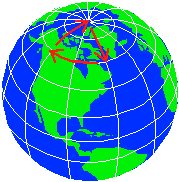 Index
Index

A bear walks south for one kilometer, then it walks west for one kilometer, then it walks north for one kilometer and ends up at the same point from which it started. What color was the bear?
The bear was white because it was a polar bear. The only place on earth where a bear can go south, west and north equal distances and end up where it started is the North Pole.
Actually, the bear could go west two or five kilometers instead of one and it would not make any difference -- the bear would be making a circle around the North Pole. East and West you travel along parallels which are circles equidistant from the poles. North and South you travel along meridians which are circles that cross both the north and the south poles.

There is another way to go south, west and north one kilometer and end up at the original point without starting at the North Pole*. Start \({1 + {1 / (2 \pi)}}\) kilometers (approx. 1.16Km) from the South Pole. Walk one kilometer south, then one kilometer west (which is a complete 1 Km circle around the South Pole), and finally, one kilometer north to the starting point. However, there are no bears in Antarctica; there are only penguins.
In the following image, the red circle represents a one-kilometer circle around the South Pole. The purple circle is separated from the red circle by one kilometer. If you start anywhere on the purple circle and walk toward the South Pole, then, upon reaching the red circle you walk west around the South Pole, and finally you walk north to the purple circle, you will have walked three kilometers and ended up at the same place from where you started.

At least one polar bear has actually been tracked by satellite traveling from Alaska to Greenland across the north pole region. Bears of other colors, e.g., grizzlies, Alaskan black bears, Russian brown bears, etc., never venture north of the continental land masses. Polar bears are not restricted by the boundaries of the land because they have partially webbed forepaws and are excellent swimmers. Their scientific name, Ursus maritimus, means "sea bear".
There is great concern that the habitat of polar bears will be destroyed if global warming continues at the same rate as during the last 25 years.